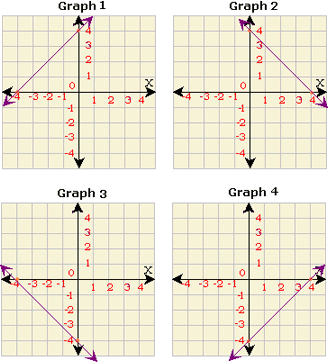Linear Equation
Definition Of Linear Equation
Linear equation is an equation of the form Ax + By = C, where A ≠ 0 and B ≠ 0. The graph of a linear equation is a straight line.
Example of Linear Equation
The following are examples of linear equations.
5x + 7y = 1, - 13x + 6y = 0.5, 
Video Examples: Beginning Algebra & Graphing Linear Equations
Solved Example on Linear Equation
Ques: Identify the graph that represents a linear function.

Choices:
A. Graph 1
B. Graph 2
C. Graph 3
D. Graph 4
Correct Answer: B
Solution:
Step 1: x + y = 4. [Given Equation.]
Step 2: (0) + x = 4 [To find x-intercept substitute y = 0.]
Step 3: x = 4 [Solve for x.]
Step 4: The x-intercept is 4. So, the line crosses the x-axis at the point (4, 0).
Step 5: y + (0) = 4 [To find y-intercept substitute x = 0.]
Step 6: y = 4 [Solve for y.]
Step 7: The y-intercept is 4. So, the line crosses the y-axis at the point (0, 4).
Step 8: Plot the points (4, 0) and (0, 4) and draw a line through them.
Step 9: Among the Graphs, Graph 2 represents the graph of the linear equation x + y = 4.
- Writing-Linear-Equations-for-the-Situations-Gr-6
- Applications-of-Linear-Equations-Gr-6
- Writing-Linear-Equations-for-the-Situations-Gr-7
- Solving-Two-step-Linear-Equations-Gr-7
- Applications-of-Linear-Equations-Gr-7
- Solving-Linear-Equations-in-One-Variable-Gr-8
- Classifying-Relations-as-Linear-or-Nonlinear-Gr-8